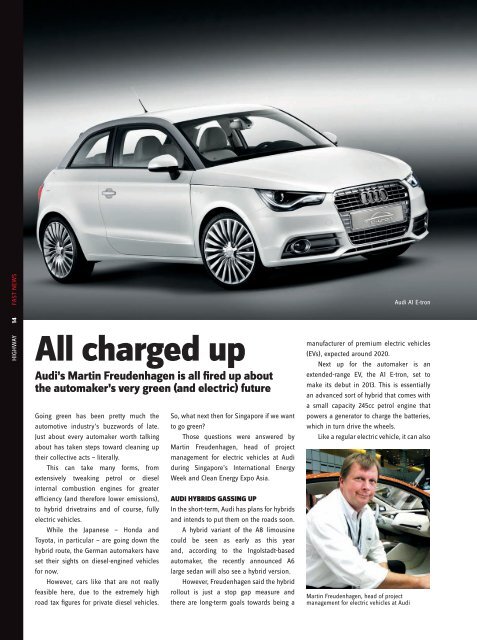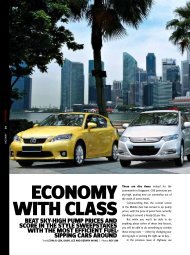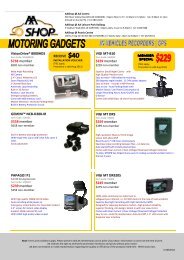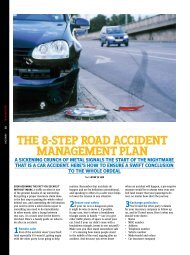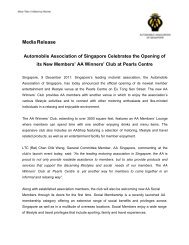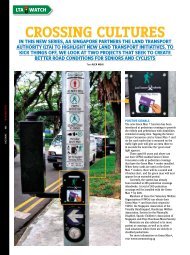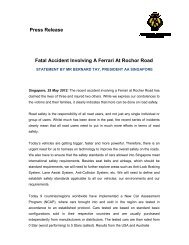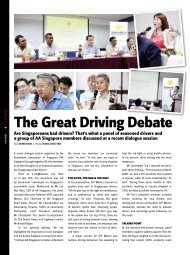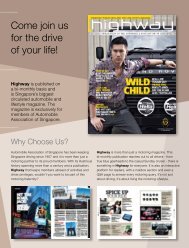06-16 FastNews.indd - Automobile Association of Singapore
06-16 FastNews.indd - Automobile Association of Singapore
06-16 FastNews.indd - Automobile Association of Singapore
Create successful ePaper yourself
Turn your PDF publications into a flip-book with our unique Google optimized e-Paper software.
HIGHWAY 14 FAST NEWS<br />
All charged up<br />
Audi’s Martin Freudenhagen is all fired up about<br />
the automaker’s very green (and electric) future<br />
Going green has been pretty much the<br />
automotive industry’s buzzwords <strong>of</strong> late.<br />
Just about every automaker worth talking<br />
about has taken steps toward cleaning up<br />
their collective acts — literally.<br />
This can take many forms, from<br />
extensively tweaking petrol or diesel<br />
internal combustion engines for greater<br />
efficiency (and therefore lower emissions),<br />
to hybrid drivetrains and <strong>of</strong> course, fully<br />
electric vehicles.<br />
While the Japanese — Honda and<br />
Toyota, in particular — are going down the<br />
hybrid route, the German automakers have<br />
set their sights on diesel-engined vehicles<br />
for now.<br />
However, cars like that are not really<br />
feasible here, due to the extremely high<br />
road tax figures for private diesel vehicles.<br />
So, what next then for <strong>Singapore</strong> if we want<br />
to go green?<br />
Those questions were answered by<br />
Martin Freudenhagen, head <strong>of</strong> project<br />
management for electric vehicles at Audi<br />
during <strong>Singapore</strong>’s International Energy<br />
Week and Clean Energy Expo Asia.<br />
AUDI HYBRIDS GASSING UP<br />
In the short-term, Audi has plans for hybrids<br />
and intends to put them on the roads soon.<br />
A hybrid variant <strong>of</strong> the A8 limousine<br />
could be seen as early as this year<br />
and, according to the Ingolstadt-based<br />
automaker, the recently announced A6<br />
large sedan will also see a hybrid version.<br />
However, Freudenhagen said the hybrid<br />
rollout is just a stop gap measure and<br />
there are long-term goals towards being a<br />
manufacturer <strong>of</strong> premium electric vehicles<br />
(EVs), expected around 2020.<br />
Next up for the automaker is an<br />
extended-range EV, the A1 E-tron, set to<br />
make its debut in 2013. This is essentially<br />
an advanced sort <strong>of</strong> hybrid that comes with<br />
a small capacity 245cc petrol engine that<br />
powers a generator to charge the batteries,<br />
which in turn drive the wheels.<br />
Like a regular electric vehicle, it can also<br />
Martin Freudenhagen, head <strong>of</strong> project<br />
management for electric vehicles at Audi<br />
Audi A1 E-tron
e charged via a conventional household<br />
electrical wall socket. Think <strong>of</strong> the internal<br />
combustion engine as a sort <strong>of</strong> backup,<br />
allowing the A1 E-tron to be driven without<br />
the charge anxieties normally associated<br />
with EVs.<br />
WILL EVERYTHING BE<br />
LIKE THIS IN THE FUTURE?<br />
It will be, but not in the near future, at least.<br />
This is due to the lack <strong>of</strong> infrastructure<br />
(charging stations and the like); whether<br />
the automaker or governments should<br />
make a move first; and concerns about the<br />
vehicles (regarding range and so on), said<br />
Freudenhagen.<br />
In the meantime, he thinks diesels —<br />
not hybrids — are the way to go, and cites<br />
the example <strong>of</strong> the Audi A3 TDI, the reigning<br />
Green Car <strong>of</strong> the Year. The A3 enjoys a 10<br />
per cent improvement in efficiency over<br />
regular petrol engines, versus hybrids that<br />
<strong>of</strong>fer a seven to nine per cent improvement.<br />
More significantly, Freudenhagen<br />
confirmed that “E-tron” will be a complete<br />
sub-brand for Audi, and will produce<br />
performance EVs that are faithful to Audi’s<br />
sporting DNA.<br />
The name “E-tron” already refers to an<br />
R8-like supercar (above) with a 0-100km/h<br />
time <strong>of</strong> just 4.8 seconds and a 248km range.<br />
It is a potential rival to other electric sports<br />
Audi E-tron<br />
cars currently on the market, such as the<br />
Lotus Elise-based Tesla.<br />
We say potential because, while the<br />
Internet rumour mill is rife with speculation<br />
on whether Audi will put the car into<br />
production, there has been no <strong>of</strong>ficial<br />
confirmation from the automaker.
Sport on!<br />
BMW’s 6 Series<br />
gets a scheduled<br />
second quarter<br />
2011 debut<br />
HIGHWAY <strong>16</strong> FAST NEWS<br />
BMW will debut its new two-door 6 Series<br />
in the second quarter <strong>of</strong> 2011 in <strong>Singapore</strong>.<br />
Production on its main production line<br />
has already started in Dingolfi ng, Germany,<br />
and the 6 Series will be manufactured<br />
alongside the 5 big sedan and 7 Series<br />
limousine — both <strong>of</strong> which the 6 Series<br />
shares common basic architecture with.<br />
The folding fabric ro<strong>of</strong> will be a first for<br />
the 6 Series cabriolet. (The coupe will follow<br />
in the fourth quarter, although no <strong>of</strong>ficial<br />
photographs <strong>of</strong> it have been released, as<br />
the car is in the design concept stages.)<br />
Its basic form takes cues from the rest<br />
<strong>of</strong> BMW’s lineup. For instance, there’s a<br />
prominent oversized and upright double<br />
kidney grille. The rest <strong>of</strong> its design is<br />
inspired by boats moving through water.<br />
It will handle like a boat too, or at least<br />
in terms <strong>of</strong> how a speedboat accelerates.<br />
Engine options available at its launch will<br />
include a 320bhp 3.0-litre six-cylinder and a<br />
407bhp 4.4-litre V8. Both powerplants will<br />
be turbocharged and will be linked to eightspeed<br />
automatic transmissions.<br />
Naturally, the car will come with an<br />
optional active body roll control system<br />
to keep things fl at and pointed through<br />
corners. It will also inherit the clever four<br />
wheel-steering system first seen on the 7,<br />
then 5 Series. At low speeds, it works to<br />
decrease the car’s turning radius and at<br />
higher speeds, allows for more deft turn-in.<br />
Other innovations include a full-colour<br />
heads-up display with three-dimensional<br />
graphics, a first for BMW’s cars.<br />
Honda’s hybrid hatchback takes on Toyota’s Prius<br />
One <strong>of</strong> the first commercially-available<br />
hybrid vehicles on the modern market was<br />
the first-generation Honda Insight back in<br />
1999. Most people know the Prius, thanks<br />
to its fame as the world’s best-selling<br />
hybrid car.<br />
Now however, the Insight has a bigger<br />
hill to climb, as the Prius is currently Japan’s<br />
most popular car in terms <strong>of</strong> monthly sales.<br />
Honda’s strategy with the Insight is to <strong>of</strong>fer<br />
a cheaper package overall, even if it doesn’t<br />
perform as well in terms <strong>of</strong> fuel economy.<br />
Honda is also trumping up the fact that it’s<br />
been tuned for drivability too.<br />
The Insight features the same<br />
“Integrated Motor Assist” hybrid system as<br />
the Civic hybrid (which is being phased out,<br />
coincidentally), but that system is now in its<br />
fifth iteration and, Honda claims, is smaller<br />
and lighter, and even better at fuel-saving<br />
than before. The system is a parallel hybrid,<br />
meaning the engine cannot be totally<br />
disconnected. Neither can it run entirely on<br />
electric power.<br />
It consists <strong>of</strong> a 1.3-litre inline fourcylinder<br />
engine with 88bhp mated to<br />
a <strong>16</strong>bhp, 78Nm electric motor, both<br />
driven through a continuously-variable<br />
transmission.<br />
Fuel efficiency is quoted as 21.7km/L,<br />
compared to 25.6km/L for the Prius. The<br />
battery pack is a nickel metal-hydride pack<br />
located beneath the boot and in between<br />
the wheels. 0-100km/h should take around<br />
12 seconds, with a maximum speed <strong>of</strong><br />
about 180km/h.<br />
A major new feature <strong>of</strong> the Insight is<br />
the “Eco Assist” mode. Unlike regular “eco”<br />
buttons, the changes it enforces to minimise<br />
fuel consumption are not limited to the<br />
drivetrain. Not only is total system output<br />
limited, but the system also smoothens out<br />
the CVT shift pattern, as well as the throttle<br />
inputs, thanks to drive-by-wire tech. The<br />
air-conditioning pattern is also modified, as<br />
is the Start-Stop function.<br />
The Insight’s trump card is pricing,<br />
though. At last count, it retails for $1<strong>16</strong>,900<br />
with COE, compared with the higher-priced<br />
Prius at $139,488 with COE. Bookings for the<br />
Insight are being collected by <strong>of</strong>ficial dealer<br />
Kah Motors, with the <strong>of</strong>fi cial launch and<br />
first deliveries in January.


